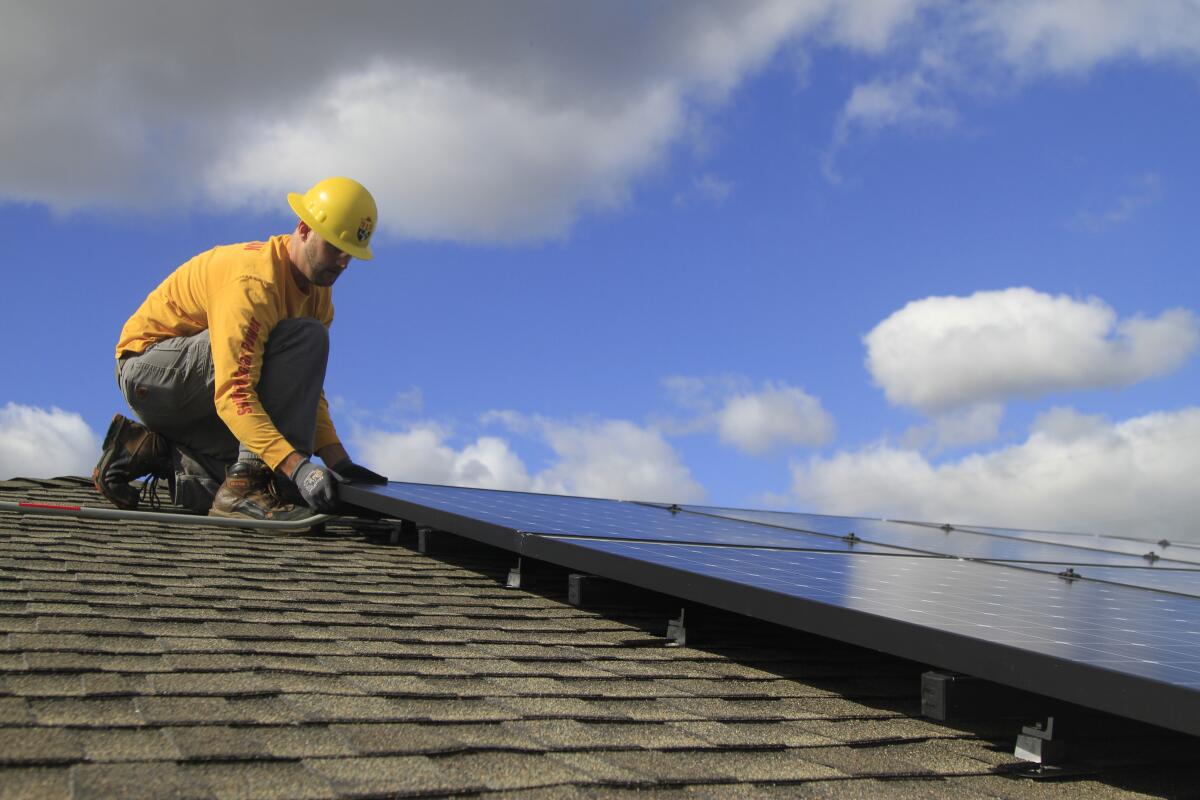California isn’t requiring rooftop solar on every new home after all

California officials voted Thursday to allow Sacramento-area developers to build homes that don’t come equipped with solar panels — a move solar installers and environmentalists said would undermine the state’s first-in-the-nation home solar requirement.
Under the proposal from Sacramento Municipal Utility District, a public power agency, home builders will be able to take credit for electricity generated by off-site solar farms, instead of constructing houses with rooftop solar panels. The utility plans to make enough off-site solar power available to serve all demand from new residential construction.
Supporters said the “community solar” program would accomplish California’s goal of boosting clean energy, and reducing the carbon emissions fueling the climate crisis, without pushing up home prices in a state facing rising homelessness and a shortage of affordable housing.
Critics countered that the whole point of the rooftop solar mandate, approved in 2018, was to make clean energy a standard feature of new homes. They said the alternate compliance option approved Thursday would result in significantly lower electricity cost savings for homeowners and would lay the groundwork for other utilities to create similar workarounds.
The debate pitted home builders, utilities and organized labor against the solar industry and environmental advocacy groups. State Sen. Scott Wiener (D-San Francisco) weighed in to support rooftop solar, but 31 other state lawmakers signed a letter urging approval of the Sacramento-area program. The letter cited the need to balance clean energy and affordable housing.
After initially postponing a decision in November, the commission sided with Sacramento Municipal Utility District, known as SMUD, in a unanimous vote on a revamped proposal.
“If it is true that it’s a much better deal for consumers to have a panel on the roof, then those are the houses that will sell. And builders know that,” Karen Douglas, one of five members of the Energy Commission, said before the vote. “Where it works, people are going to want the solar. And that’s what we’re going to overwhelmingly see.”
Another commissioner, Janea Scott, said the Sacramento-area program “may not be perfect, but I don’t think we should let the perfect be the enemy of the good.”

Commission officials acknowledged homeowners will see smaller bill savings under SMUD’s Neighborhood SolarShares program than they would with solar panels on their roofs.
The average single-family home in the utility’s service territory, which covers most of Sacramento County and parts of Placer and Yolo counties, can currently save around $75 a year with rooftop solar, the Energy Commission estimated. Under SMUD’s program, the average single-family home will be guaranteed electricity bill reductions of just $28 a year.
Home solar installers worried the Sacramento-area program would set a precedent that will limit the growth of rooftop panels in other parts of the state. Several utilities, including Pacific Gas & Electric and the Los Angeles Department of Water and Power, submitted comments to the Energy Commission urging approval of SMUD’s proposal. An LADWP official told The Times that the utility isn’t developing an alternative compliance program for the home solar mandate, but could do so in the future if there’s demand from home builders.
Critics also said homes without rooftop solar panels would have less incentive to install lithium-ion batteries, which can generate further cost savings and also help families keep the lights on during blackouts — a growing concern as some utilities shut off power to prevent wildfires.
Batteries also reduce the need for utilities to fire up planet-warming natural gas plants in the evening to meet electricity demand after sundown. The more homes that store solar power on-site for use after dark, the lower the evening demand utilities must supply — and the less need for fossil fuels on the grid.
“This is not solar versus solar. This is the smart buildings of the future, versus the dumb buildings of the past,” Bernadette Del Chiaro, executive director of the California Solar & Storage Assn., an industry trade group, told the Energy Commission before Thursday’s vote.
Clean energy advocates are talking about what comes next — and warning that climate change demands faster action.
San Francisco-based Sunrun Inc., one of the nation’s largest rooftop solar and battery installers, described SMUD’s proposal as “a step backward for clean energy.”
“Community solar should be an accessible and affordable option for homeowners if rooftop solar is not a good fit, but it should not erode the Title 24 standards,” Sunrun said in a letter to the Energy Commission, referring to the building code update that included the home solar requirement. “To meet its climate, clean energy and energy resiliency goals, California should remain committed to building zero-carbon homes that have lower load, less burden on the distribution system, and are prepared to endure power outages.”
When the commission first approved the home solar requirement, it gave builders the option of supplying power from an off-site “community solar” facility, mollifying critics who said rooftop panels would price some home buyers out of the market. Environmentalists figured the option would be used sparingly, by multifamily developments without sufficient space for rooftop solar.
But SMUD put forward a much broader proposal, giving builders the ability to avoid installing rooftop solar for all new homes in the Sacramento area.
After the commission declined to approve the initial proposal, SMUD made some changes.
The utility pledged that off-site solar power serving new homes would come from small-scale facilities within its service territory, abandoning plans to utilize several sprawling utility-scale solar projects, including one in faraway Fresno County. It also doubled the guaranteed bill savings for homeowners, up to $28 a year for an average single-family home.
Steven Lins, SMUD’s director of government affairs, said the utility is committed to net-zero carbon emissions by 2040 and plans to invest more than $6 billion to achieve that goal.
But he also made the common utility industry argument, disputed by the solar industry, that rooftop solar systems cause energy bills to rise for customers who can’t afford solar — a so-called “cost shift.” The less revenue a utility gets from solar customers, the argument goes, the more it will have to raise rates for everyone else to pay the costs of running the grid.

Lins pointed out that meeting California’s climate change goals will likely require widespread adoption of electric cars, electric heat pumps and electric water heaters to phase out oil and natural gas, both of which are planet-warming fossil fuels. Consumers are unlikely to invest in those electric cars and appliances if electricity gets more expensive, Lins said.
“We’re looking at all the customers, and trying to optimize our system for them,” he told the Energy Commission.
The changes from SMUD’s initial proposal didn’t convince critics from several prominent environmental groups, including the Sierra Club and the Center for Biological Diversity. They argued the solar projects SMUD plans to use for its program are too large and generally too far from residential neighborhoods to be considered true “community” solar facilities.
A community solar program “should increase climate resilience, reliability and energy efficiency in the same way as rooftop solar,” Sierra Club California staffer Lauren Cullum wrote in a letter to the Energy Commission. She said the benefits should include bill savings as well as local job creation and training, especially in communities burdened by pollution.
“SMUD’s proposal simply does not deliver any of these benefits of true community solar,” Cullum wrote.
Several utilities, including Pacific Gas & Electric and the Los Angeles Department of Water and Power, submitted comments supporting SMUD. An LADWP official alluded to the disputed “cost shift” argument, writing that LADWP, like SMUD, is “dedicated to achieving our green energy goals while ensuring costs are borne equitably among our ratepayers.”
“We applaud SMUD for designing an innovative program that provides participants with a lower-cost option for obtaining additional, durable solar power without shifting the financial burden to SMUD’s other customers,” wrote Reiko Kerr, LADWP’s senior assistant general manager for power system engineering.
Utility employees with the International Brotherhood of Electrical Workers also supported SMUD’s proposal. Jobs building grid-connected solar facilities are generally union jobs. Jobs installing rooftop solar panels are largely non-union.








